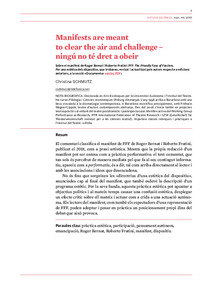Manifests Are Meant to Clear the Air and Challenge – Nobody Has the Right to Obey
Metadata
Show full item record
Estudis escènics: quaderns de l'Institut del Teatre. 2019, Núm. 44
Document typeArticle
Abstract
<p>The commentary classifies Roger Bernat’s and Roberto Fratini’s FFF manifest, published in 2018, as an artistic praxis. It shows that the drafting itself of a manifest can be understood as a performative practice: the commented text, which is only perceived in a mediate manner in terms of its information content, appears as performative; in other words, as it directly reaches the readers and with the associations and ideas it unleashes.</p>
<p>It is not until the “guidelines of an aesthetics of devices” emerge, announced towards the end of the manifest, that it also becomes the description of an aesthetic programme. In its turn, this aesthetic practice can target political objectives while creating an aesthetic confusion, unfolding a critical effect on itself and acting as a call to an autonomous performance. The readers of the manifest, as well as the audience of an FFF performance, can adopt and put into practice a stance of their own within the debate that this provokes.</p> <p>El comentari classifica el manifest de FFF de Roger Bernat i Roberto Fratini, publicat el 2018, com a praxi artística. Mostra que la pròpia redacció d’un manifest pot ser entesa com a pràctica performativa: el text comentat, que tan sols és percebut de manera mediata pel que fa al seu contingut informatiu, apareix com a<em> performatiu</em>, és a dir, tal com arriba directament al lector i amb les associacions i idees que desencadena.</p>
<p>No és fins que sorgeixen les «directrius d’una estètica del dispositiu», anunciades cap al final del manifest, que també esdevé la descripció d’un programa estètic. Per la seva banda, aquesta pràctica estètica pot apuntar a objectius polítics i al mateix temps causar una confusió estètica, desplegar un efecte crític sobre ell mateix i actuar com a crida a una actuació autònoma. Els lectors del manifest, com també els espectadors d’una representació de FFF, poden adoptar i posar en pràctica un posicionament propi dins del debat que això provoca.</p>
Access conditionsOpen Access
ISSN2385-362X
,
0212-3819
Collections
- 2019: Núm.: 44 [22]


